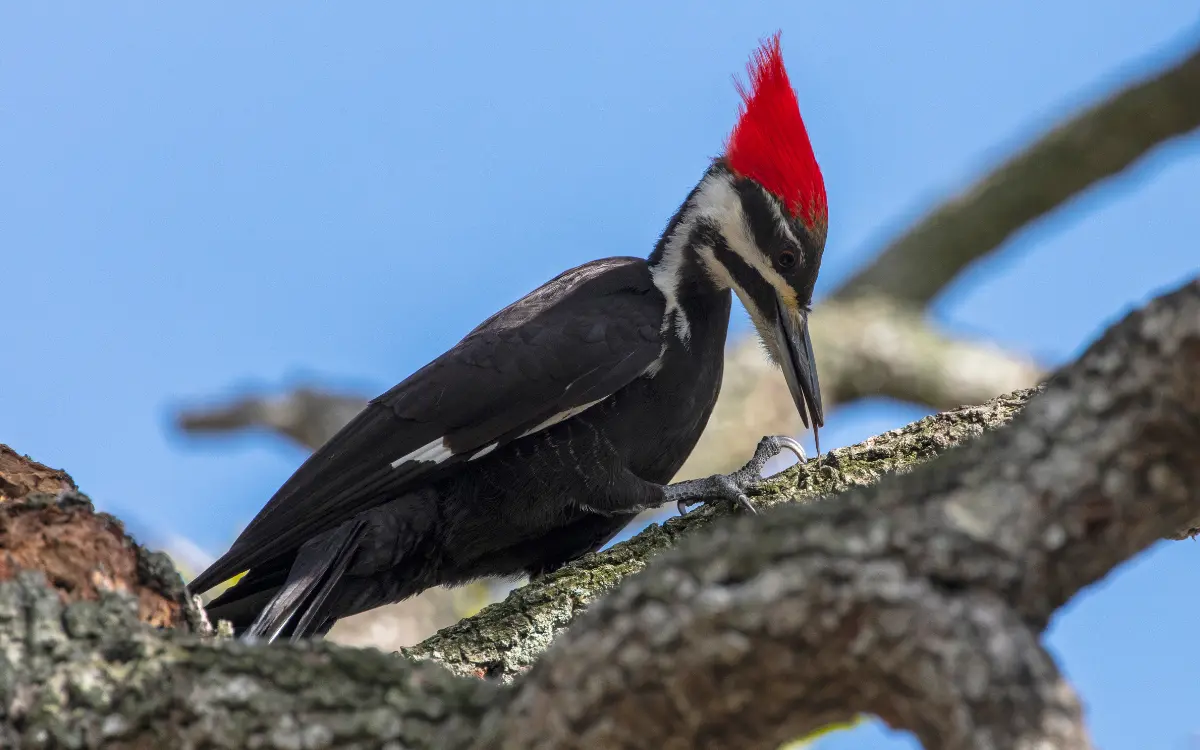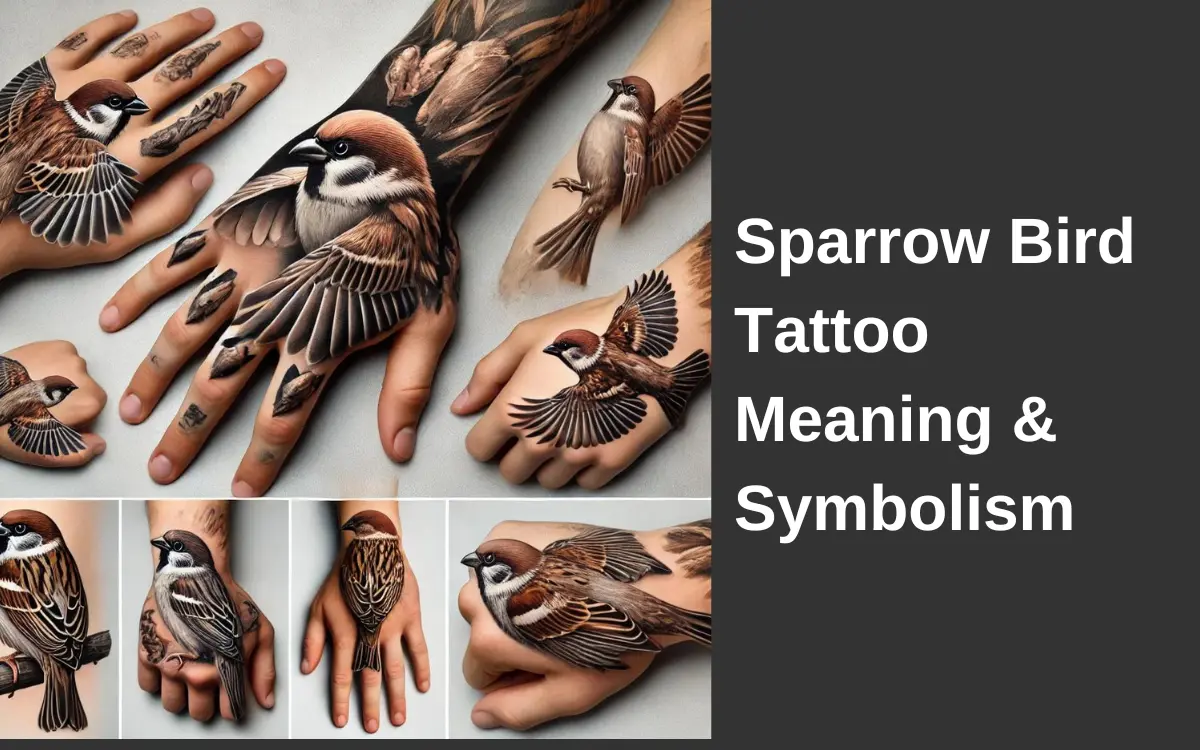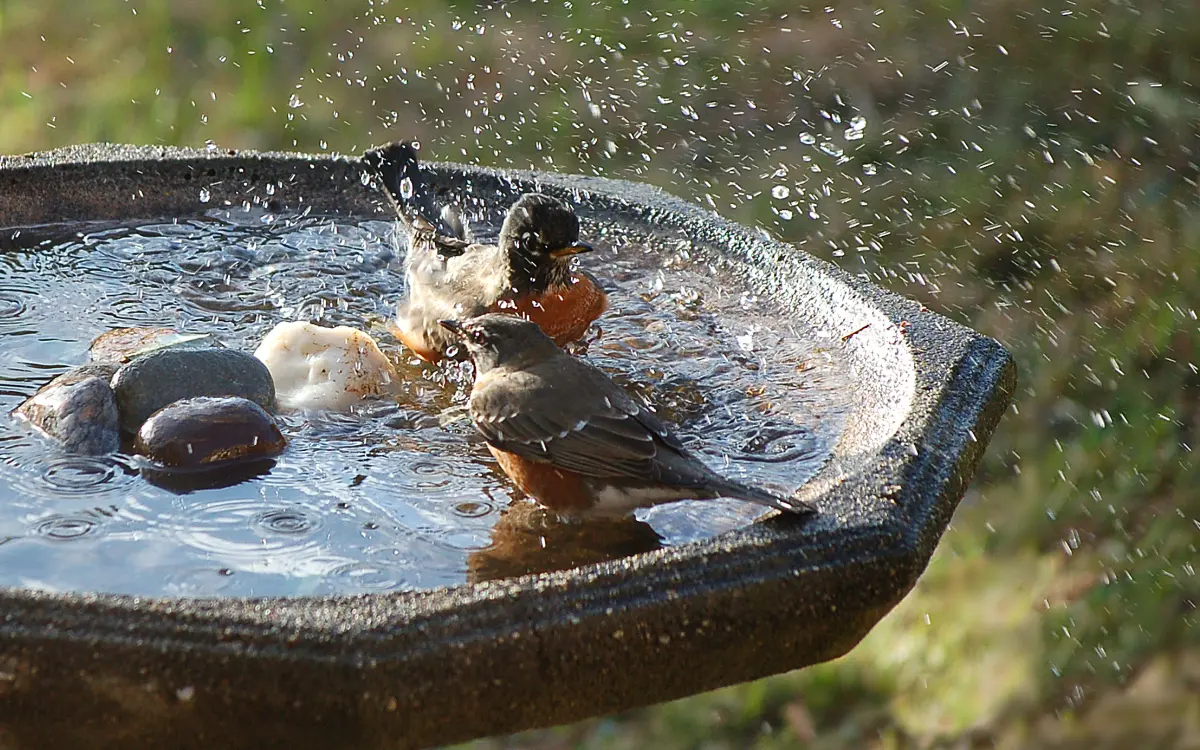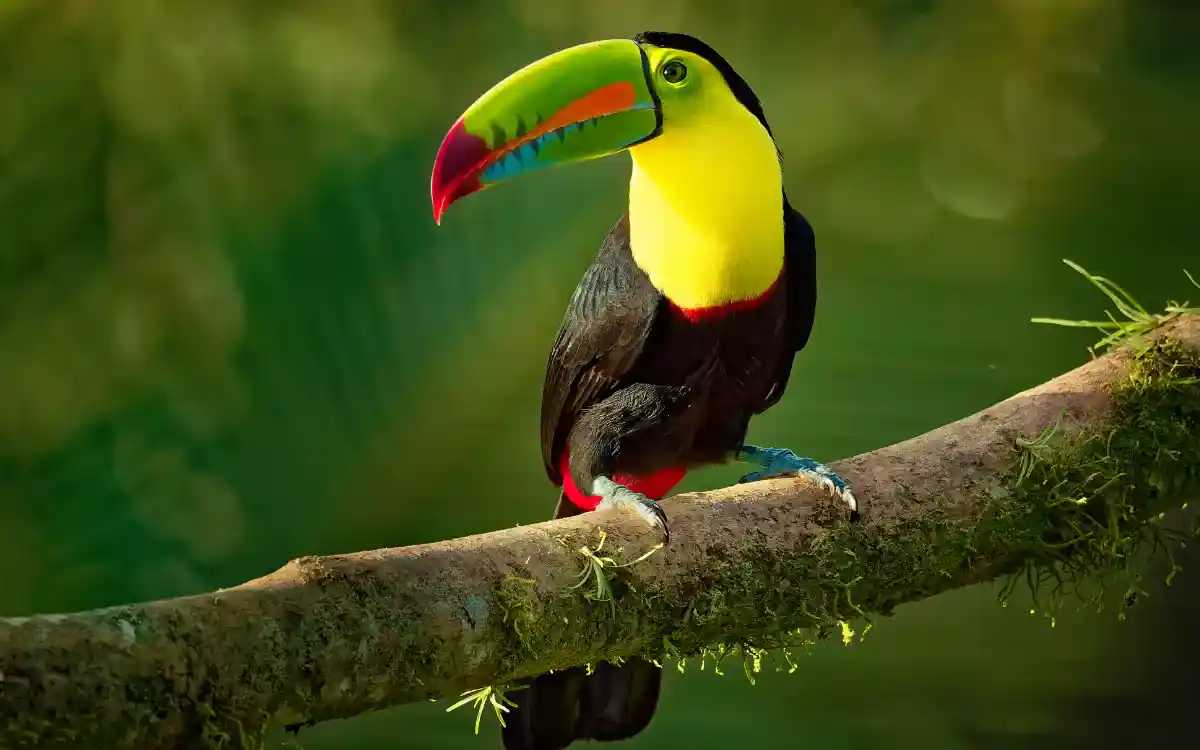7 Bird similar to a robin (Habits,nest,behavior)
Have you ever seen a bird that reminds you of a robin? Colorful, lively, and full of personality – this bird is a real treat for anyone, especially eighth graders! Let’s dive into its fascinating world together.
List of 7 Bird similar to a robin
1. Red Breasted Nuthatch
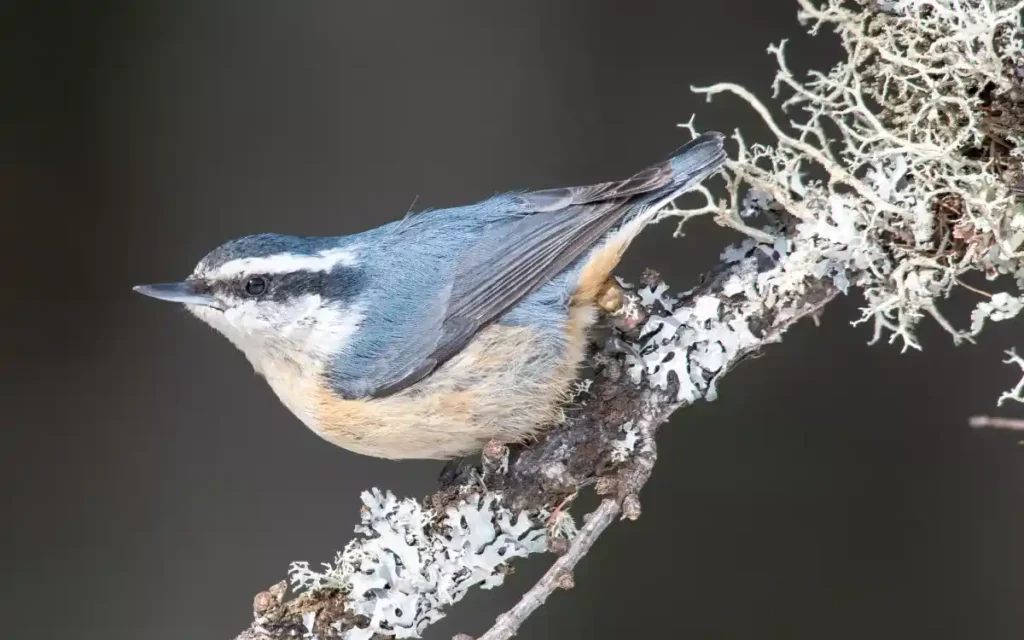
The Red-breasted Nuthatch primarily resides in coniferous forests, including spruce, fir, pine, hemlock, and others. They adapt to various habitats, including deciduous woods and mixed forests. These environments provide the resources necessary for their survival and nesting.
Feeding Habits
These birds are agile foragers, mainly feeding on insects and arthropods like beetles, caterpillars, spiders, ants, and earwigs during summer. In the colder months, their diet shifts to conifer seeds, often those stored earlier. They are known for their unique foraging behavior on tree trunks and branches.
Nesting Behavior
Red-breasted Nuthatches exhibit interesting nesting habits. Both sexes are involved in creating the nest, with the female playing a more significant role. They prefer dead trees or parts of live trees for nesting, and the nest is lined with various materials for comfort. The use of conifer resin at the nest’s entrance is a notable aspect of their behavior.
Reproduction and Development
The female lays 5-6 eggs, which are incubated for about 12-13 days. Both parents are involved in feeding the young. The nestlings leave the nest approximately 2-3 weeks after hatching and remain near their parents for another two weeks before venturing out independently.
2. Varied Thrush
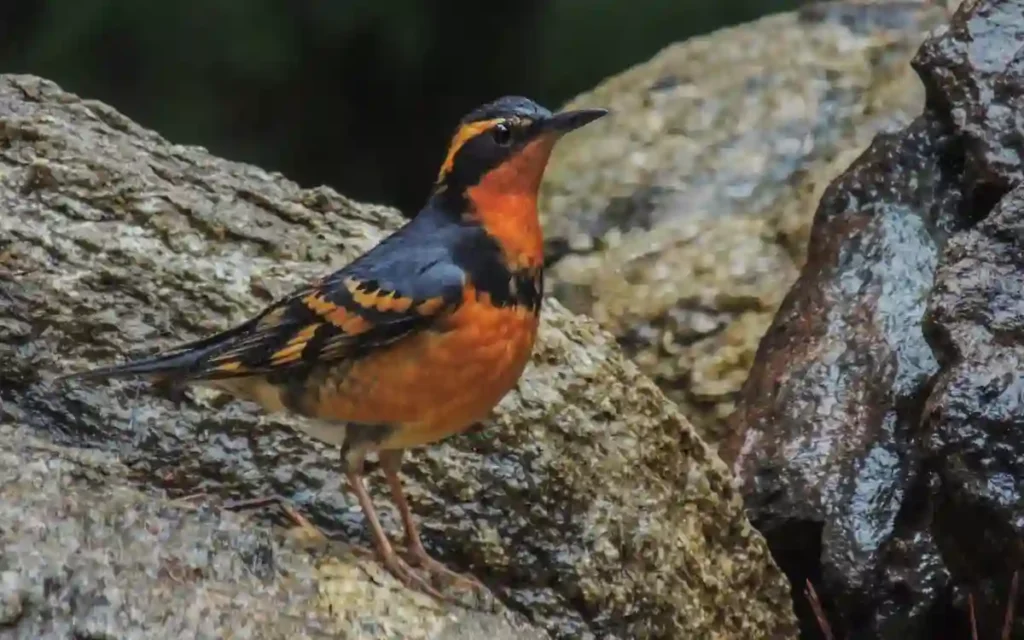
Habitat
The Varied Thrush inhabits dark, wet, mature forests in the Pacific Northwest. This bird’s breeding range includes areas from Alaska to northern California, with forests dominated by coastal redwood, Sitka spruce, red alder, western hemlock, western red cedar, western larch, or Douglas-fir. In winter, it broadens its range to include parks, gardens, lakeshores, and riparian areas rich in fruit and berries.
Feeding Habits
During breeding season, Varied Thrushes primarily eat insects and other arthropods found in leaf litter. Their winter diet shifts to berries and nuts. These birds exhibit a unique foraging technique, using their bill to clear spots on the ground before examining them for prey. They form loose flocks around food sources in fall and winter.
Nesting Behavior
Female Varied Thrushes are likely responsible for selecting the nesting site, usually in the understory of mature forests and often in conifers. Their nests, which are around 10 feet off the ground and close to the trunk of a small conifer, are poorly concealed.
The nest is made of an outer layer of twigs, a middle layer of materials like rotten wood and moss, and an inner lining of fine grasses and moss. The clutch size ranges from 1 to 6 eggs, with 1-2 broods per year.
Reproduction and Development
Eggs are light sky blue, sometimes with dark-brown speckles, and incubation lasts about 12 days. The nestling period is around 13-15 days.
Chicks are born with their eyes closed and bodies mostly bare, with sparse patches of gray down. Both parents feed the nestlings.
Behavior
Varied Thrushes forage on the ground and move to higher perches to sing or move between foraging sites. Males arrive at breeding grounds before females to establish territories, engaging in threat displays and occasional skirmishes with rivals.
They are thought to establish monogamous breeding pairs, although the duration of these pairings is not well known.
Conservation
While still common, Varied Thrush populations have declined due to habitat loss from logging and forest fragmentation. These birds are vulnerable to window strikes and predation near human habitation. They are listed as a species of concern due to their steep decline in numbers despite their widespread distribution.
3. Eastern Towhee
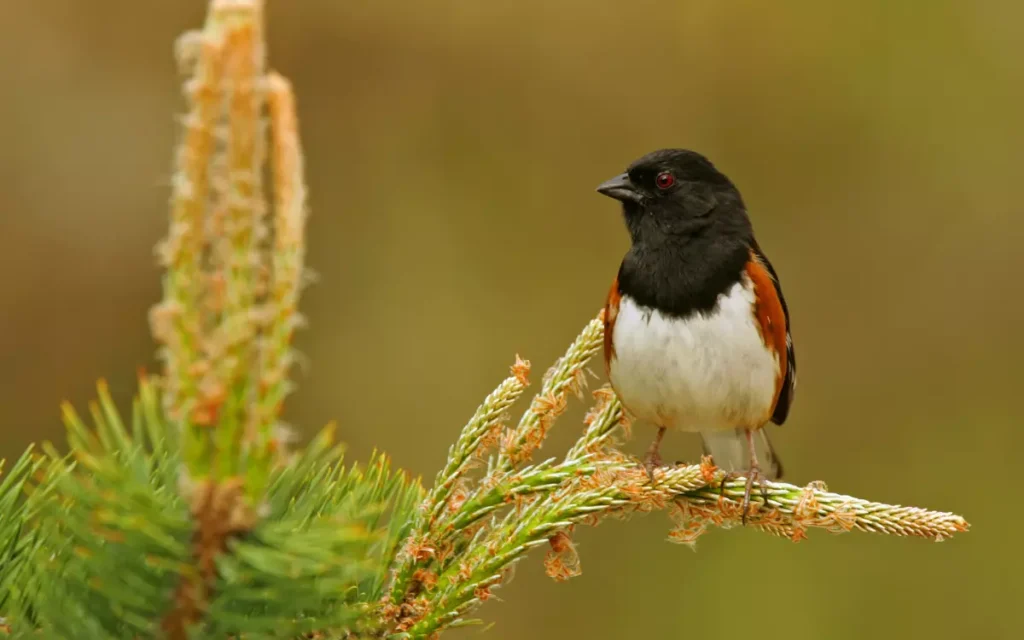
Habitat
Eastern Towhees are typically found in forest edges, overgrown fields, woodlands, and thickets. They thrive in environments with dense shrub cover and abundant leaf litter for foraging. These birds are adaptable to various elevations, favoring warm and dry south-facing slopes.
Feeding Habits
Eastern Towhees have an omnivorous diet, including seeds, fruits, insects, spiders, millipedes, centipedes, and snails. They also consume soft leaf and flower buds in spring, along with seeds and fruits like ragweeds, smartweeds, grasses, acorns, blackberries, and blueberries.
Nesting Behavior
Nesting primarily on the ground, Eastern Towhees build their nests sunk into fallen leaves. Sometimes, they construct nests in shrubs or tangles of vines up to about 4 feet off the ground. The nest comprises a 4-inch wide outer cup made of various natural materials and an inner cup lined with fine grasses and rootlets. Only the female is responsible for building the nest, typically completing it within five days.
Reproduction and Development
The clutch size ranges from 2 to 6 eggs, with 1-3 broods per year. Eggs are creamy, grayish, pinkish, or greenish-white, speckled with brown and other colors. The incubation period lasts about 12-13 days, and the nestling period is about 10-12 days. Both parents feed the nestlings.
Behavior
Eastern Towhees are ground foragers, known for their characteristic scratching in leaf litter. They are also seen creeping through thick shrubs. The males become more visible during nesting season, singing from high perches. These birds are known for their distinctive tail flicking and flashing, especially in response to disturbances or other towhees.
Conservation
While Eastern Towhees are widespread and commonly seen, their population has declined significantly in recent decades. This decline is attributed to habitat changes, such as the development of subdivisions and the growth of shrublands into forests.
For more detailed information about the Eastern Towhee, visit All About Birds, Audubon, and NestWatch.
Read also: Red Robin Bird Symbolism Spiritual Meaning
4. Orchard Oriole
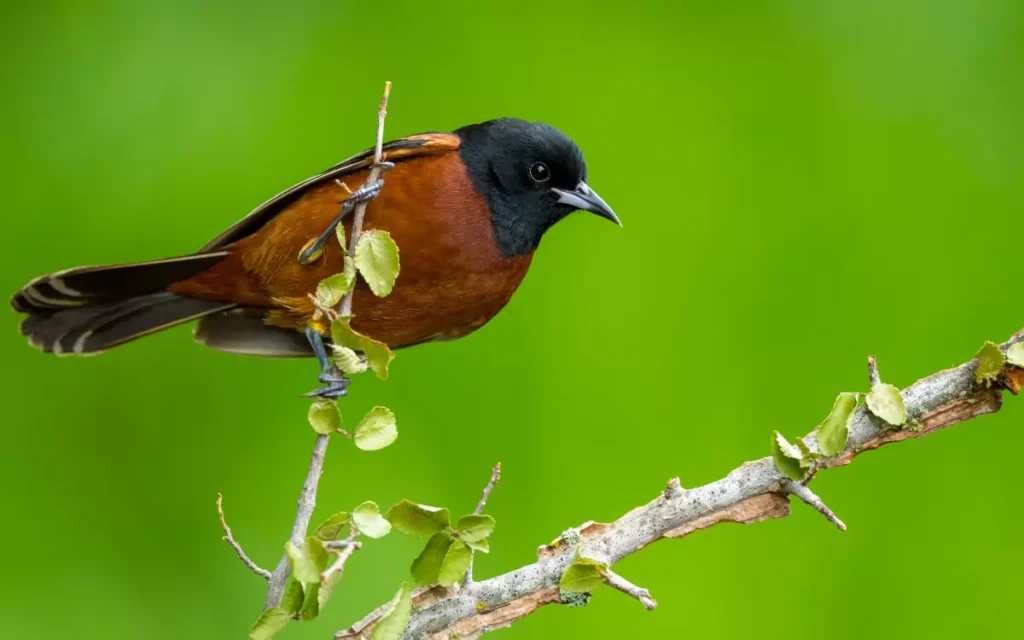
Habitat
Orchard Orioles are commonly found in open woodlands, particularly along river edges, as well as in marsh edges, lakeshores, open shrublands, and farms. They prefer habitats with scattered trees, making them frequent residents in orchards, gardens, and suburban areas. During winter, they inhabit thickets and lightly wooded areas in Central America, often at elevations up to a mile above sea level.
Feeding Habits
Their diet mainly consists of insects, other arthropods, some fruits, and nectar. Orchard Orioles skillfully glean prey like wasps, ants, caterpillars, and spiders from foliage. They also adapt their feeding behavior to include nectar from flowers and hummingbird feeders, sometimes piercing flowers at their bases to access nectar directly. Their diet shifts to mostly fruits before fall migration, often foraging on ripe mulberries and other berries.
Nesting Behavior
Orchard Orioles build their nests in a variety of trees like maple, ash, cottonwood, and elm, usually attaching them to forked twigs or branches away from the main trunk. These nests are constructed of grass woven into a cup shape, lined with fine grass, plant down, wool, and feathers. The female predominantly builds the nest, usually completing it in about 6 days.
Reproduction and Development
The clutch size typically ranges from 4 to 6 eggs, with 1 to 2 broods per season. The eggs are light blue or gray with dark markings, and the incubation period lasts about 12-14 days. Both parents are involved in feeding the nestlings, which leave the nest after about 11-14 days. The young may stay with their parents for several weeks after fleeing.
Behavior
Orchard Orioles are monogamous within each breeding season but find new mates each year. They arrive at breeding grounds in late spring, often raising a single brood before departing in mid to late summer. The species is known for its breeding displays, including bows and seesawing motions. They show little aggression towards other bird species and may nest in proximity to other orioles, kingbirds, robins, and sparrows.
Conservation
While Orchard Orioles are fairly common, their populations have declined by over 1% annually, amounting to a cumulative decline of approximately 46% between 1966 and 2019. Habitat loss, particularly in riverine areas, and parasitism by cowbirds are key challenges for their conservation. However, they are currently rated as a species of low conservation concern.
5. Hermit Thrush
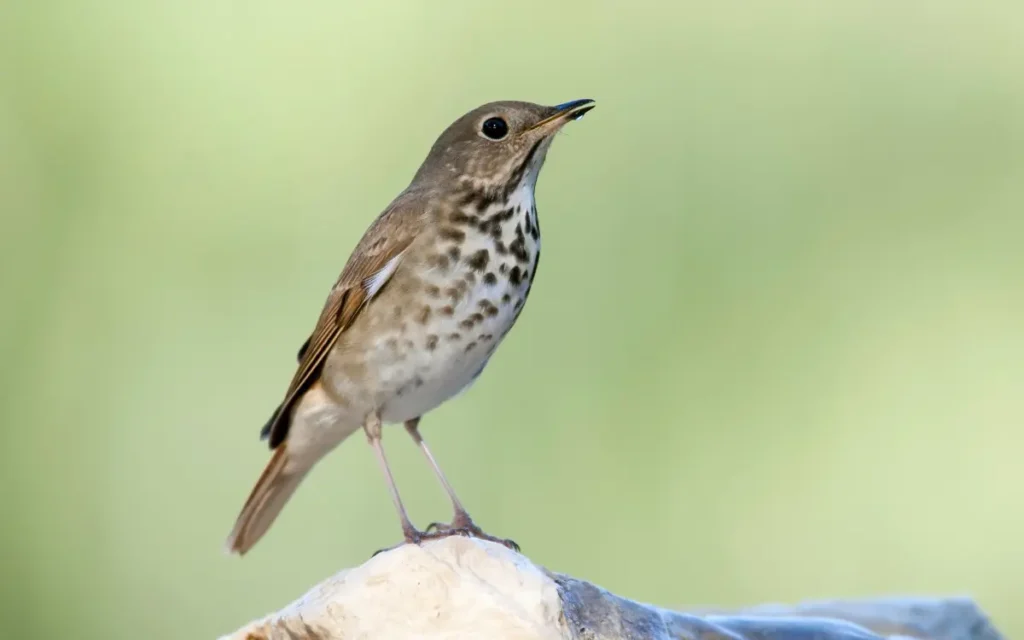
Habitat
The Hermit Thrush inhabits a variety of environments, from boreal forests in the far north to deciduous woods and mountain forests. They are often found in open areas within forests, such as trails, pond edges, and places with fallen trees. During winter, they prefer lower-elevation forests with dense understory and berry bushes, including pine, broadleaf evergreen, and deciduous woods. In Mexico, they are also seen around streams and urban lawns.
Feeding Habits
In spring, the Hermit Thrush’s diet mainly consists of insects like beetles, caterpillars, bees, ants, wasps, and flies. They also occasionally consume small amphibians and reptiles. In winter, their diet shifts to include more fruit, particularly wild berries.
Nesting Behavior
Hermit Thrushes nest either on the ground or low in vegetation, commonly beneath small conifer trees or shrubs. They select open spaces near berry and fern thickets, pasture edges, and forest roads. The nesting habits vary geographically: east of the Rocky Mountains, they typically nest on the ground, while in the west, they prefer nesting off the ground in shrubs or tree branches. The nests are generally built by the female using materials like grass, leaves, pine needles, and bits of wood, with mud and lichen around the outside.
Reproduction and Development
Clutch size ranges from 3 to 6 eggs, with 1 to 2 broods per year. Eggs are light blue, sometimes spotted with brown, and the incubation period lasts about 11-13 days. The nestling period is about 10-15 days, and both parents are involved in feeding the young.
Behavior
Hermit Thrushes are known for their foraging behavior on the forest floor, often hopping and staying still, peering at the ground to find insects. They are characterized by lifting their tail upward and then slowly lowering it, often accompanied by wing flicking. During courtship, the male chases the female in circles, and the pair may adopt a slower flying pattern after a day or two. In winter, they often forage in groups with small forest songbirds.
Conservation
The Hermit Thrush population has remained relatively stable from 1966 to 2019. They are considered a species of low conservation concern, with a global breeding population of 72 million. However, like most migratory songbirds, they face risks from collisions with transmission towers and skyscrapers during night migration. Forest fires, while a natural part of many forest ecosystems, can displace them for several years while the forest regenerates.
6. American Redstart :
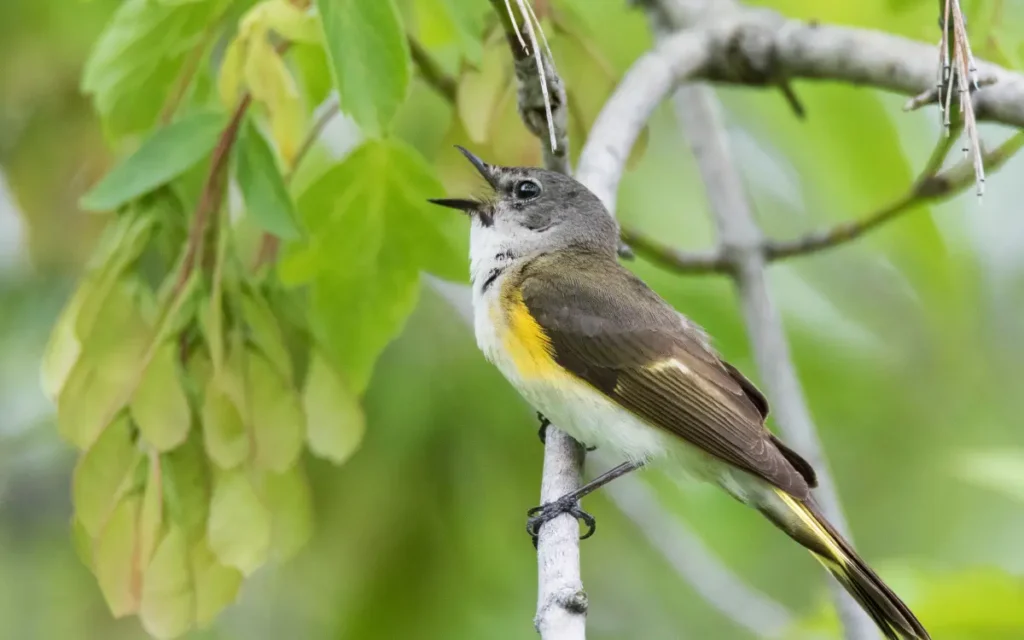
Habitat
American Redstarts breed in moist, deciduous, second-growth woodlands with abundant shrubs, primarily in the eastern and northern United States and southern Canada. Their preferred habitats are often near water and include diverse settings like alder and willow thickets, old-growth forest gaps, orchards, and mixed deciduous-coniferous woodlands.
They favor interior woodlands over edges and large habitat tracts. In the western part of their range, they are found in riverside woods and coniferous forests. For wintering, they move to habitats in southern Florida and California, as well as southern and western Mexico, Central America, and the Caribbean, including mangroves, coffee plantations, scrub thickets, and urban areas.
Feeding Habits
American Redstarts primarily feed on insects such as leafhoppers, planthoppers, flies, moths, wasps, and beetles. In late summer, their diet expands to include small berries and fruits like barberry, serviceberry, and magnolia. They forage across various levels, from ground to canopy, often displaying their distinctive plumage to startle and flush prey from vegetation. They are adept at catching flying insects, more so than many other warbler species.
Nesting Behavior
The male American Redstart shows potential nesting sites to the female during courtship, but she ultimately chooses the location. Common nesting trees include maple, birch, ash, hawthorn, alder, and willow.
The female builds the nest, which is a tightly woven cup of fibers like birch bark strips, grasses, and milkweed seed hairs, along with animal hairs, feathers, rootlets, and wasp nest paper. The construction takes about 3-7 days, and nests are well camouflaged by foliage.
Reproduction and Development
The clutch size ranges from 1 to 5 eggs, with an incubation period of 10-13 days. The nestling period is about 7-13 days. The eggs are white or creamy with blotches, and hatchlings are helpless with closed eyes and sparse downy feathers. After the chicks leave the nest, parents split feeding duties, with each taking care of certain chicks.
Behavior
Males defend territories with songs and aerial displays, while females may also defend against other females. The American Redstart is known for its polygamous tendencies, with males sometimes having two mates in separate territories. Foraging adults can fall prey to raptors, and nests are vulnerable to climbing predators and brood parasites like Brown-headed Cowbirds.
Conservation
Although their population has slightly declined, American Redstarts are generally stable with an estimated global breeding population of 42 million. They are considered a species of low conservation concern. However, they face threats from habitat loss on breeding and wintering grounds and are vulnerable to collisions with man-made structures and pesticide poisoning.
7. Black-headed Grosbeak
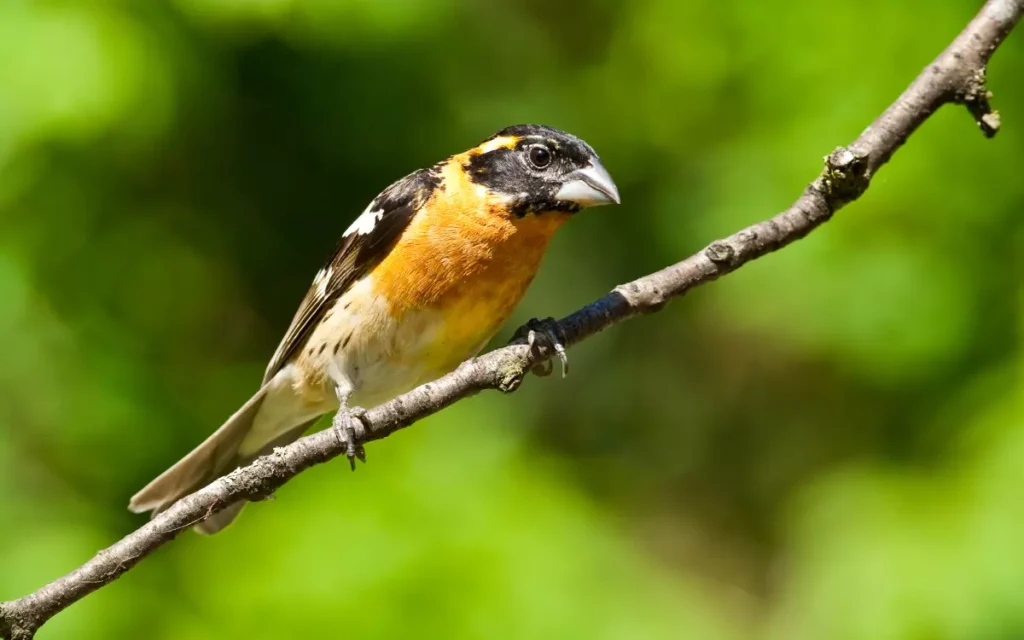
Habitat
Black-headed Grosbeaks breed in diverse habitats with a variety of plants and access to water. They prefer areas with large trees and thick undergrowth, avoiding monotonous landscapes like dry chaparral, dense coniferous forests, or grasslands. Ideal habitats include groves of cottonwood or aspen near water, pine forests, deciduous canyons, and even suburban areas with gardens and orchards. In winter, they migrate to subtropical and tropical lowlands in Mexico with similar environmental features, and during migration, they seek out areas rich in berries.
Feeding Habits
Their massive bills are ideal for cracking seeds and crushing hard-bodied insects or snails. About 60% of their diet during breeding season comprises insects, spiders, and other small animals, with the rest being fruits and seeds. They consume a variety of berries during migration and are one of the few bird species that can safely eat poisonous monarch butterflies, thanks to their physiological insensitivity to the toxins these butterflies carry.
Nesting Behavior
Nests are usually built on outer branches of small deciduous trees or bushes, often near streams, and at heights up to about 25 feet. The nests, built by females, are loosely constructed and well camouflaged. Materials used include twigs, stems, rootlets, pine needles, and finer elements like hair and string for the lining. The construction process typically takes 3 to 4 days.
Reproduction and Development
Clutch size ranges from 2 to 5 eggs, with a typical incubation period of 12-14 days. Nestlings are helpless at birth, with sparse downy feathers, and they leave the nest after 10-14 days. Both parents participate in feeding the chicks and share the chick-rearing duties almost equally.
Behavior
Black-headed Grosbeaks are active foragers, gleaning food in the treetops and understory. They exhibit distinctive courtship behaviors, including the male’s “nuptial flights.” Both males and females sing, which helps in territorial defense. They are known to aggressively protect their territory and nest from intruders. In the fall, these birds may form loose flocks during migration.
Conservation
The population of Black-headed Grosbeaks has been stable or increasing in most of their range, except for certain areas like Coastal California and New Mexico. Estimated at about 15 million globally, they are rated as a species of low conservation concern. Their adaptability in terms of habitat and diet has helped them thrive in various environments, although they are sensitive to habitat changes due to urbanization.
FAQS:
Q: Is there a bird similar to a robin?
Ans: Yes, birds similar to robins include the Varied Thrush, Spotted Towhee, and Eastern Towhee. They share certain features with robins, like body shape or color patterns.
Q: Are there different types of robins?
Ans: The term “robin” can refer to different birds across the world. In North America, the most common is the American Robin. Other regions have their own robin species, like the European Robin.
Q: What Oregon birds look like robins?
Ans: In Oregon, birds like the Varied Thrush and Spotted Towhee can resemble robins due to their size and coloration.
Q: Gray bird that looks like a robin?
Ans: A bird that is gray and resembles a robin might be the Eastern Towhee or a female Varied Thrush, both of which have grayish aspects in their plumage.
Q: Brown bird similar to a robin?
Ans: The female Eastern Towhee, which is more brown than black, can appear similar to a robin.
Q: Bird that looks like a robin but no red breasts?
Ans: The Spotted Towhee, while having some similarities to robins, does not have a red breast. It has a white belly and rufous sides instead.
Q: Bird that looks like a robin with spots?Ans:
Ans: The Spotted Towhee is a bird that looks somewhat like a robin but has distinctive white spots on its wings and back.
Conclusion
While various birds like the Varied Thrush, Spotted Towhee, and Eastern Towhee share similarities with robins, each species exhibits unique traits that distinguish them in appearance and behavior.


